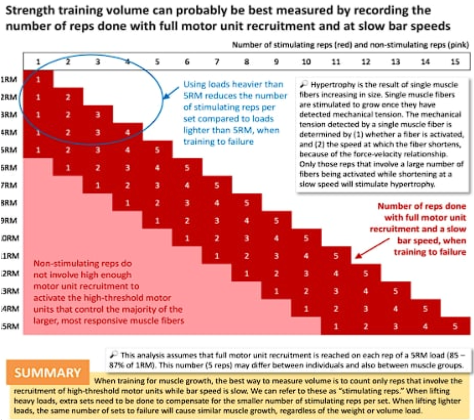amiok
Iron
- Joined
- Oct 1, 2025
- Posts
- 127
- Reputation
- 84
Many users on this forum said that I’m a low iq and greycel, it touched my ego so I’m going to make a guide on what I know best. And I haven’t seen anyone did a science based lifting guide
1. Mechanical Tension
Many people have known the main factor that causes muscle growth is microtears, but recent studies showed that it’s a misconception. Muscle growth is based on mechanical tension, the pulling force that a single muscle fiber both produces and experiences when under load or resistance ( like lifting heavy weights ). By that means, you won’t need to do 50 reps in a set to gain more muscle or strength but you just only need to do 5 reps to gain even more muscle with less fatigue. You can get high mechanical tension when doing a rep super slow, but not high motor unit recruitment ( MUR ), which I’ll explain later. You’ll probably think “so I can just do 5 reps with no effort to gain muscle?”. Actually no, that’s when MUR come 2. Motor Unit Recruitment
A motor unit is made up of a motor neuron as well as the muscle fibers it controls, when you need to use your muscle, your brain will signal to recruit the necessary motor units so the muscle fibers can complete the task. Because your body is energy-efficient, it only recruits as many units as it needs for the activity. So when you do a high intensity training, the MUR will send feedback to your brain that the lift was too heavy, then your brain will tell it to get stronger next time. Moreover, there are two types of muscle fibers, type 1 fiber and type 2 fiber, just imagine the type 1 is the weak and small one while type 2 is stronger, bigger. That’s why we have to maximize the MUR used in a training as much as possible, especially the type 2 fibers. To maximize MUR, you’ll need to train high intensity, low reps ( good range: 5 reps because we can gain as much strength and hypertrophy as possible ) and with maximum effort, you’ll eventually get high mechanical tension from it because when you’re training to failure, the weights your lifting will be super slow because you are at your limit.
3. Fatigue, atrophy and recovery
This is really depends on your split, but the ideal frequency (applies on every muscle area) is 6-8 sets. For example, if I’m doing Upper Lower, I’ll do 2 sets of every muscle I target in Monday and repeat until Friday. And atrophy happens in 48 hours after the last time you stimulate your muscle so that’s why UL and FBEOD is one of the most optimal splits.
4. Compound and isolate
If you’re a beginneer (<6 months) in working out, it is recommended that you should train more compound movements than isolating the muscle, because when your body is new to training high intensity, because of MUR deficit, the MUR can’t recruit as much muscle fibers as they can so they have to adapt to recruiting muscle fibers (and when you’re new, you may have to deal with having good form, doing full range of motion, etc).
5. Leverages
Don’t listen to Jeff Nippard saying training a muscle while keeping the deep stretch in the eccentric, stretch does not mediate hypertrophy and he’s still coping with the deep stretch. The muscle areas like delt, chest, bicep and tricep will be trained best when doing its movements (leverages). I’ll list some of them: for bicep it’s the elbow flexion, chest is horizontal adduction, etc…
In summary
How to train optimal: do 2 sets with 5 reps full effort and to failure, you can teeth clench using a mouthguard (or something similar), and fist clench (holding your fist really hard on something), do these methods when you’re close to failure.
1. Mechanical Tension
Many people have known the main factor that causes muscle growth is microtears, but recent studies showed that it’s a misconception. Muscle growth is based on mechanical tension, the pulling force that a single muscle fiber both produces and experiences when under load or resistance ( like lifting heavy weights ). By that means, you won’t need to do 50 reps in a set to gain more muscle or strength but you just only need to do 5 reps to gain even more muscle with less fatigue. You can get high mechanical tension when doing a rep super slow, but not high motor unit recruitment ( MUR ), which I’ll explain later. You’ll probably think “so I can just do 5 reps with no effort to gain muscle?”. Actually no, that’s when MUR come 2. Motor Unit Recruitment
A motor unit is made up of a motor neuron as well as the muscle fibers it controls, when you need to use your muscle, your brain will signal to recruit the necessary motor units so the muscle fibers can complete the task. Because your body is energy-efficient, it only recruits as many units as it needs for the activity. So when you do a high intensity training, the MUR will send feedback to your brain that the lift was too heavy, then your brain will tell it to get stronger next time. Moreover, there are two types of muscle fibers, type 1 fiber and type 2 fiber, just imagine the type 1 is the weak and small one while type 2 is stronger, bigger. That’s why we have to maximize the MUR used in a training as much as possible, especially the type 2 fibers. To maximize MUR, you’ll need to train high intensity, low reps ( good range: 5 reps because we can gain as much strength and hypertrophy as possible ) and with maximum effort, you’ll eventually get high mechanical tension from it because when you’re training to failure, the weights your lifting will be super slow because you are at your limit.
3. Fatigue, atrophy and recovery
This is really depends on your split, but the ideal frequency (applies on every muscle area) is 6-8 sets. For example, if I’m doing Upper Lower, I’ll do 2 sets of every muscle I target in Monday and repeat until Friday. And atrophy happens in 48 hours after the last time you stimulate your muscle so that’s why UL and FBEOD is one of the most optimal splits.
4. Compound and isolate
If you’re a beginneer (<6 months) in working out, it is recommended that you should train more compound movements than isolating the muscle, because when your body is new to training high intensity, because of MUR deficit, the MUR can’t recruit as much muscle fibers as they can so they have to adapt to recruiting muscle fibers (and when you’re new, you may have to deal with having good form, doing full range of motion, etc).
5. Leverages
Don’t listen to Jeff Nippard saying training a muscle while keeping the deep stretch in the eccentric, stretch does not mediate hypertrophy and he’s still coping with the deep stretch. The muscle areas like delt, chest, bicep and tricep will be trained best when doing its movements (leverages). I’ll list some of them: for bicep it’s the elbow flexion, chest is horizontal adduction, etc…
In summary
How to train optimal: do 2 sets with 5 reps full effort and to failure, you can teeth clench using a mouthguard (or something similar), and fist clench (holding your fist really hard on something), do these methods when you’re close to failure.





 my grey rage is about to explode
my grey rage is about to explode